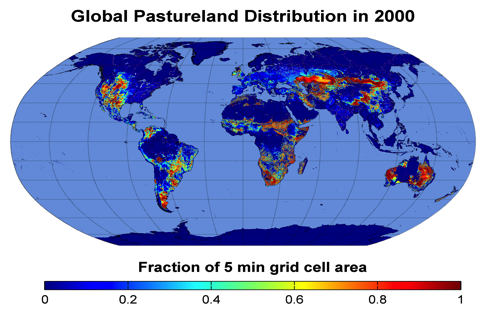Task 1. Development of a Global Pasture Productivity Model
Impact and Rationale. As indicated in the figure below, pasture land is widely distributed globally and occupies a substantial fraction of the world's land area, and in particular a considerably larger area than is used to grow row crops.

Global Pastureland Distribution. (For 2000, from Ramankutty et al., 2008)
Pasture intensification may well be the lever with the largest potential impact on bioenergy production potential. Consider:
- According to a comprehensive agro-ecological zoning study conducted by the Brazilian Ministry of Agriculture, there are about 60 million hectares of available land presently occupied with degraded pasture that can be used for sugarcane with no significant impact on environment and biodiversity (Lynd et al., 2011). This may be compared to the 4 million hectares Brazil currently uses to produce 34 billion liters of ethanol and provide for about half of the light duty transportation fuel consumed.
- A preliminary analysis indicates that 125 million hectares of crop and pasture land could be made available by increasing pasture intensification in the US. Mapping the biomass productivity potential of this land (e.g., using a multi-crop productivity model such as that proposed in Task 2) has not yet been undertaken and would be of interest. At a perhaps modest average productivity of 10 Mg/ha and anticipated fuel yields (Laser et al., 2009), the biofuel production potential is 80% of US gasoline consumption and a third of global gasoline consumption1.
- Replacing current global petroleum use would require about 10% of pasture land with high but achievable productivities and process yields.2
Approach. We propose development of a global pasture productivity model, which does not now exist. This will allow estimation of the pasture "yield gap," corresponding to the difference between the potential and actual yields.
Several approaches to such development are possible. Pasture yield potential and yield gap can be estimated by a "Climate Zones" method involving sorting current productivity of managed pasture land into "bins" based on climatic variables (e.g., degree days, precipitation) and statistically evaluating the impact of various management variables. This approach is very similar to that widely employed by Jon Foley and his group at the University of Minnesota to estimate the yield gap for row crops (Monfreda et al., 2008; Licker et al., 2010). An alternative "Net Primary Productivity" method involves applying models for the productivity of unmanaged lands (e.g., Zaks et al., 2007; Del Grosso et al., 2008), again as a function of climatic variables. Preliminary analysis indicates a pasture intensification potential of not less than 2-fold via both methods3.
Further refinement of these and perhaps other methods is planned to estimate the pasture yield gap and, in conjunction with the bioenergy crop model (see Task 2), to evaluate the bioenergy potential of pasture intensification. It would be desirable to examine a few major pasture regions in more detail – e.g. Brazil, the US, China, and perhaps others – for the purpose of exemplification and validation.
Land use and land cover databases are foundation for analysis anticipated as part of the GSB project. The sufficiency of existing databases for the purposes of the GSB project will be evaluated, and work to improve or integrate these may be undertaken. In particular, land use estimates from globally-focused "top down" methods will be compared with more locally-focused "bottom-up analyses" such as that planned in the LACAf project (see Supporting Organizations).
Leadership. Leaders for Task 1 activities have not yet been named.
1Pete Vadas, USDA Dairy Forage Center, Madison, Wisconsin
2Richard Hamilton, Ceres Corporation
3Ashley Morishige in collaboration with Lee Lynd, John Sheehan, Nathan Mueller, Jon Foley. Institutions represented: University of Minnesota and Dartmouth College.
References
- Del Grosso, D.G., W. Parton, T. Stohlgren, D. Zheng, D. Bachelet, S. Prince, K. Hibbard, R. Olson. 2008. Global potential net primary production predicted from vegetation class, precipitation, and temperature. Ecology 89:2117-2126.
- Laser, M., E. Larson, B. Dale, M. Wang, N. Greene, L.R. Lynd. 2009. Comparative analysis of efficiency, environmental impact, and process economics for mature biomass refining scenarios. Biofuels, Bioprod. Biorefin. 3:247-270.
- Licker, R., M. Johnston, J.A. Foley, C. Barford, C.J. Kucharik, C. Monfreda, N. Ramankutty. 2010. Mind the gap: How do climate and agricultural management explain the yield gap of croplands around the world? Global Ecol. Biogeog. 19:769-782.
- Lynd, L.R., Ramlan Abdul Aziz, Carlos Henrique de Brito Cruz, Annie Fabian Abel Chimphango, Luis Augusto Barbosa Cortez, Andre Faaij, Nathanael Greene, Martin Keller, Patricia Osseweijer, Tom L. Richard, John Sheehan, Archana Chugh, Luuk van der Wielen, Jeremy Woods and Willem Heber van Zyl. 2011. A global conversation about energy from biomass: The continental conventions of the global sustainable bioenergy project. Interface Focus 1:71-279.
- Monfreda, C., N. Ramankutty, and J.A. Foley. 2008. Farming the planet: 2. Geographic distribution of crop areas, yields, physiological types, and net primary production in the year 2000. Global Biogeochem. Cycles 22:GB1022, doi:10.1029/ 2007GB002947.
- Ramankutty, N., A.T. Evan, C. Monfreda, J.A. Foley. 2008. Farming the planet: 1. Geographic distribution of global agricultural lands in the year 2000. Global Biogeochem. Cycles 22:B1003, doi:10.1029/2007GB002952.
- Zaks, D.P.M., N. Ramankutty, C.C. Barford, J.A. Foley. 2007. From Miami to Madison: Investigating the relationship between climate and terrestrial net primary production. Global Biogeochemical Cycles 21:GB3004, doi:10.1029/2006GB002705.
